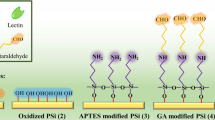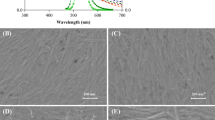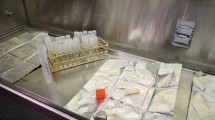Abstract
We have developed a new surface for use in biosensors that is based on a gold plate covered with a specific carbohydrate receptor structure. The carbohydrate, Galα1–4Gal, was bound covalently via a thioalkylcarboxy–spacer, or adsorbed as a neoglycoprotein, to a two–dimensional gold surface. Both types of surfaces showed high specificity in the binding of the uropathogenic bacteria P–fimbriated Escherichia coli compared to the binding of non–infectious bacteria. The signal to noise ratio is sufficiently high to allow specific detection of the bacteria in biosensor applications.
This is a preview of subscription content, access via your institution
Access options
Subscribe to this journal
Receive 12 print issues and online access
$209.00 per year
only $17.42 per issue
Buy this article
- Purchase on Springer Link
- Instant access to full article PDF
Prices may be subject to local taxes which are calculated during checkout
Similar content being viewed by others
References
Karlsson, K.-A. 1989. Animal glycosphingolipids as membrane attachment sites for bacteria. Annu. Rev. Biochem. 58: 309–350.
Feizi, T. 1993. Oligosaccharides that mediate mammalian cell-cell adhesion. Current Opinion in Structural Biology 3: 701–710.
Nilsson, B., Larsson, A.-L., Ögren, Y., Back, M. and Nilsson, K.G.I. 1988. An amplification technology for improving sensitivity when measuring components in biological samples. J. Immunol. Methods 108: 237–244.
Blum, L.J. and Coulet, P.R. 1991. Biosensor Principles and Applications. Marcel Dekker, New York.
Svanborg-Edén, C., Freter, R., Hagberg, L., Hull, R., Leffler, H. and Schoolnik, G. 1982. Inhibition of experimental ascending urinary tract infection by an epithelial cell-surface receptor analogue. Nature 298: 560–562.
Raether, H. 1988. Surface Plasmons on Smooth and Rough Surfaces and on Gratings. Springer Verlag, Berlin.
Bain, C.D. and Whitesides, G.M. 1988. Molecular-level control over surface order in self-assembled monolayer films of thiols on gold. Science 240: 62–63.
Ihs, A. and Liedberg, B. 1992. Chemisorption of L-cysteine and 3-mercaptopro-pionic acid on gold and copper surfaces:an infrared reflection-adsorption study. J. Interface Colloid Sci. 144: 282–292.
Malmqvist, M. 1993. Biospecific interaction analysis using biosensor technology. Nature 361: 186–187.
Fägerstam, L.G. and O'Shannessy, D.J. 1993. Surface plasmon resonance detection in affinity technologies, p. 229–252. In: Handbook of Affinity Chromatography. Kline, T. (Ed.). Marcel Dekker, New York.
Badimon, L., Badimon, J.J., Turitto, V.T. and Fuster, V. 1987. Thrombosis, studies under flow conditions. Ann. New York Acad. Sci. 516: 527–540.
Muramatsu, H., Watanabe, Y., Hikuma, M., Ataka, T., Kubo, I., Tamiya, E. and Karube, I. 1989. Piezoelectric crystal biosensor system for detection of Escherichia coli. Anal. Lett. 22: 2155–2164.
Ebersole, R.C., Foss, R.P. and Ward, M.D. 1991. Piezoelectric cell growth sensor. Bio/Technology 9: 450–454.
Mandenius, C.-F., Welin, S., Danielsson, B., Lundström, I. and Mosbach, K. 1984. The interaction of proteins and cells with affinity ligands covalently coupled to silicon surfaces as monitored by ellipsometry. Anal. Biochem. 137: 106–114.
Bertilsson, L. and Liedberg, B. 1993. Infrared study of thiol monolayer assemblies on gold:preparation, characterization and functionalization of mixed monolayers. Langmuir 9: 141–148.
Author information
Authors and Affiliations
Rights and permissions
About this article
Cite this article
Nilsson, K., Mandenius, CF. A Carbohydrate Biosensor Surface for the Detection of Uropathogenic Bacteria. Nat Biotechnol 12, 1376–1378 (1994). https://doi.org/10.1038/nbt1294-1376
Received:
Accepted:
Issue Date:
DOI: https://doi.org/10.1038/nbt1294-1376



